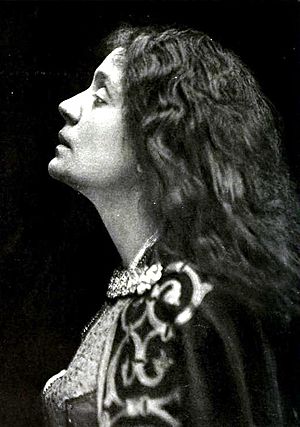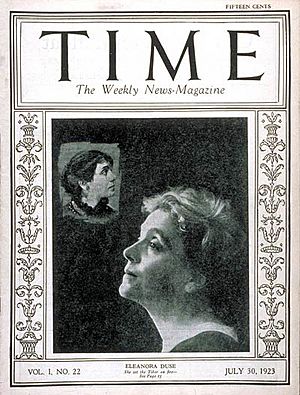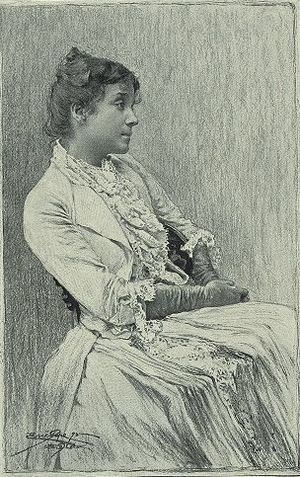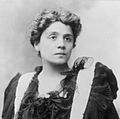Eleonora Duse facts for kids
Quick facts for kids
Eleonora Duse
|
|
|---|---|

Portrait of Eleonora Duse
|
|
| Born |
Eleonora Giulia Amalia Duse
3 October 1858 |
| Died | 21 April 1924 (aged 65) Pittsburgh, Pennsylvania, U.S.
|
| Other names | Duse |
| Spouse(s) |
Tebaldo Checchi
(m. 1881; div. 1885) |
| Children | 1 |
Eleonora Giulia Amalia Duse (DEW-zay; 3 October 1858 – 21 April 1924), often known simply as Duse, was a famous Italian actress. Many people thought she was the best actress of her time. She performed in many countries, especially in plays by Gabriele d'Annunzio and Henrik Ibsen. Duse became very good at acting by truly understanding her characters. She felt like she "became" the person she was playing, rather than just pretending.
Contents
Life and Career
Duse was born in Vigevano, Lombardy, in 1858. Her parents were Alessandro Vincenzo Duse and Angelica Cappelletto. Both her father and her grandfather, Luigi, were actors from Chioggia, near Venice. Eleonora joined their acting group when she was only four years old.
Because her family was poor, she worked all the time. She traveled from city to city with different acting groups. She became famous for playing roles that another famous actress, Sarah Bernhardt, had made popular. One of these roles was in the play La Dame aux camélias.
Early Success and Tours
Duse first became very successful in Europe. Then, she toured South America, Russia, and the United States in 1893. She started these tours as someone not very well known. But she left with everyone recognizing her amazing talent.
While she became famous performing in the popular plays of her day, she is now remembered more for her work with plays by Gabriele d'Annunzio and Henrik Ibsen.
In 1879, while in Naples, she met a journalist named Martino Cafiero. They had a close relationship. However, less than a year later, he left her while she was expecting a baby. The baby did not survive, and soon after, Cafiero also died.
Duse then joined Cesare Rossi's theater company. There, she met actor Tebaldo Checchi. They married in 1881. By 1882, they had a daughter named Enrichetta Angelica. But they separated after Duse became close with another actor, Flavio Andò.

At this time, her acting career was doing very well, and her popularity grew. She traveled on tour to South America. When she returned a year later, she started her own acting company. This meant she also became a manager and director.
Relationships and Rivalries
In 1895, Duse met Gabriele d'Annunzio, who was five years younger than her. They became close and also worked together professionally. Gabriele d'Annunzio wrote four plays for her. Their connection was widely known.
A big argument happened when d'Annunzio gave the main role for his play 'La città morta to Sarah Bernhardt instead of Duse. After this, Duse ended her relationship with him.
Duse was a private person and rarely gave interviews. She found public appearances distracting. She once told a journalist that away from the stage, "I do not exist." In contrast, Sarah Bernhardt enjoyed publicity.
Bernhardt and Duse were often seen as rivals for many years. People frequently compared their acting talents. Those who thought Duse was the better artist included George Bernard Shaw. He saw both actresses perform the same play in London within a few days. Shaw preferred Duse and strongly supported his choice.
Dame Ellen Terry, who knew both actresses, said, "How pointless it is to make comparisons! It's much better to be thankful for both these women."
In 1896, Duse had a very successful tour of the United States. In Washington, President Grover Cleveland and his wife attended every one of her performances. Mrs. Cleveland surprised society by holding the first-ever White House tea for an actress, in Duse's honor. Duse stopped acting in 1909.
Personal Life
Around the time Duse stopped acting, she met Lina Poletti. They lived together in Florence for two years before their relationship ended. Duse is also said to have had a relationship with Russian count and painter Alexander Wolkoff. She lived in his palace in Venice, which is now called Palazzo Barbaro Wolkoff.
Acting Philosophy
Duse was known for being mysterious about her acting style. She said she didn't have any special technique. She also disliked attempts to turn her art into a science. What is known is that she had a very unique, almost spiritual way of acting. She aimed to "eliminate the self" and truly become the characters she played.
It's a common misunderstanding that her acting was purely natural and unplanned. In reality, she worked very hard on her craft.
Her biographer, Frances Winwar, wrote that Duse used little makeup. Instead, she "made herself up morally." This means she let the inner feelings, sadness, and joys of her characters use her body to express themselves. This often affected her health.
According to the 1911 Encyclopædia Britannica, "her art depended on intense naturalness rather than stage effect." It was about deep understanding and strong feeling, not just dramatic showiness.
Throughout her career, Duse was respected for helping young actors and actresses. Many artists said Duse inspired them. These include modern dance pioneer Martha Graham and Imagist poetry pioneer Amy Lowell. She was also good friends with actress Eva Le Gallienne, who wrote a book about her life.
Later Life

Duse had poor health for most of her adult life, especially with her lungs. Many years of touring had made her tired. She stopped acting in 1909. However, she returned to the stage in 1921 for performances in Europe and America.
During this time, in 1916, she made one film called Cenere ("Ashes"). Copies of this film still exist today. She was very disappointed with her work in the movie. She later wrote to the French singer Yvette Guilbert asking her not to see "that stupid thing, because you'll find nothing, or almost nothing, of me in that film."
There were also some professional letters between Duse and D. W. Griffith, a famous film director. But nothing came of their talks.
On 30 July 1923, Duse became the first woman and the first Italian person to be featured on the cover of the new magazine Time.
Death
Duse died from pneumonia at age 65 in Pittsburgh. She was staying in Suite 524 of the Hotel Schenley. This happened while she was on her way back east during a tour of the United States. The Hotel Schenley is now the William Pitt Union at the University of Pittsburgh. A bronze plaque in the lobby remembers her death.
Her body was moved to New York City, where it was displayed for four days before her funeral. Then, her body was returned to Italy, where another service was held.
She is buried in Asolo, where she had lived for the last four years of her life. Her grave is in the cemetery of Sant' Anna. In 1933, her daughter Enrichetta gave some of her mother's belongings to the state. These items are kept in the Museo Civico in Asolo. In 1968, her granddaughter Eleonora Ilaria Bullough donated the last items to the Giorgio Cini Foundation in Venice.
Duse was the subject of a biographical film in 1947 called Eleonora Duse.
Images for kids
-
In Goldoni's The Mistress of the Inn, 1891
-
A portrait by John Singer Sargent, around 1893
-
Eleonora Duse on a 1958 postage stamp of the Soviet Union
See also
 In Spanish: Eleonora Duse para niños
In Spanish: Eleonora Duse para niños










